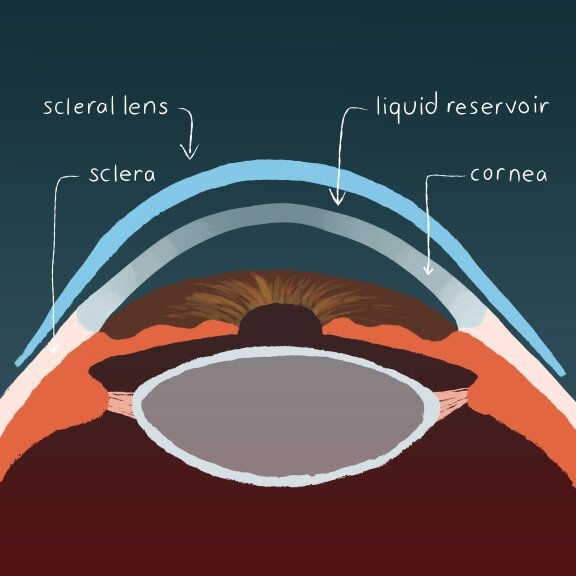Scleral Lenses

What Are Scleral Lenses?
Scleral lenses are a larger lens than most standard contacts that vaults over the cornea and sits on the white of the eye (the sclera) which is a less sensitive part of the eye to provide surprising comfort and stability for the contact lens wearer. There is a reservoir of saline solution between the back of the lens and the front of the cornea which keeps the eye in a liquid environment, providing the ideal environment for ocular healing. Unlike their glass predecessors, these newer scleral lenses are designed with a breathable gas permeable material, which ensures that plenty of oxygen reaches the eye, leading to a more comfortable lens wearing experience.
Scleral Lenses can be used to treat or manage a variety of eye conditions such as :
Keratoconus : One of the most common reasons for a referral to a specialty lens clinic. Keratoconus is essentially a cone shaped cornea that can come forward. As the condition progresses, the shape of the cornea is altered, which distorts vision. This can cause extreme light sensitivity and difficulties during night time driving. Usually, keratoconus affects both eyes, although symptoms and progression in each eye may differ. Their irregular, cone-shaped corneas cannot be properly corrected using glasses or traditional contact lenses. Scleral lenses are therefore the ideal solution. They sit on the sclera without touching the cornea, while providing sharpness, clarity and comfort in vision.
Corneal Transplants : A corneal transplant is a surgical procedure that replaces diseased or scarred corneal tissue with a healthy cornea from a donor. Following certain corneal surgeries, there can be a significant amount of irregular astigmatism which glasses may not fully correct. If the cornea becomes irregular some patients may experience light sensitivity, double vision, and/or poor vision. These Patients can be considered for a consultation to see if the lens would help their symptoms. Scleral lenses can be a great and comfortable option to correct such irregular astigmatism.
Dry Eyes : Patients may find themselves constantly using preservative free artificial tears and/or ointments at bedtime, yet still find themselves plagued by the symptoms of dry eye. Those with Dry Eye Syndrome may find traditional contact lenses difficult to wear. Specialty lenses, specifically scleral lenses, have been used to help these patients cope with a majority of their symptoms. Given that scleral lenses contain a tear reservoir between the back of the lens and cornea, the front surface of the eye remains moist and comfortable all day long.
